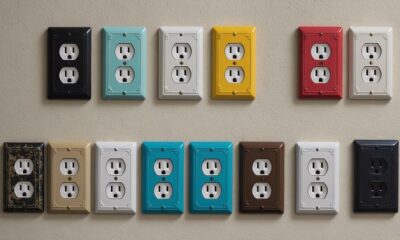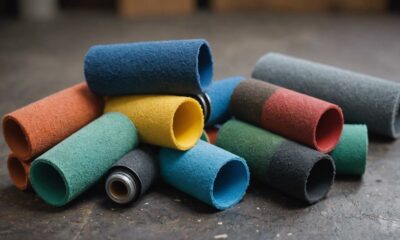Comforter
Are Comforters Safe for Newborns
Considering the safety risks, discover why comforters are not recommended for newborns and what alternatives are safer and more suitable for their sleep.
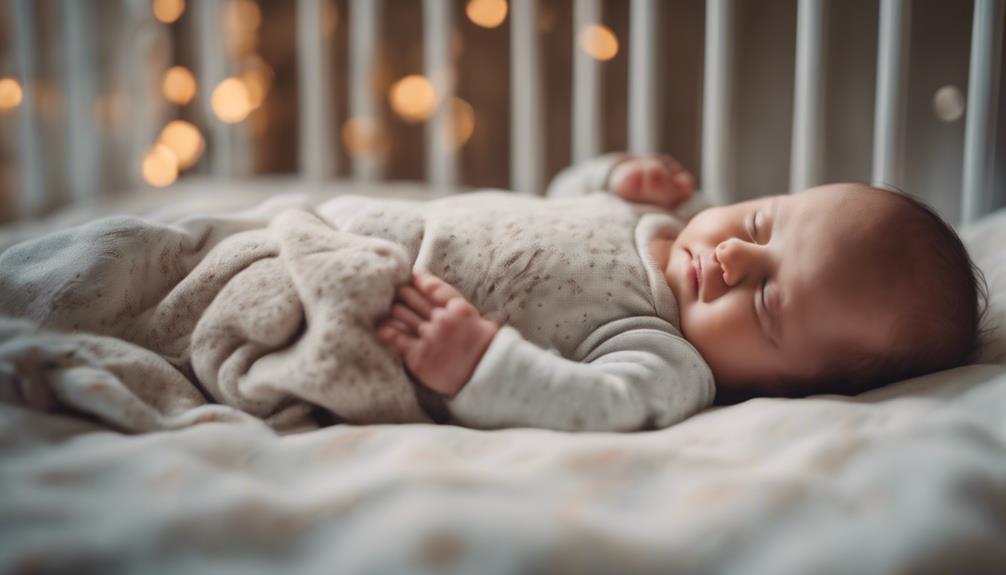
Comforters pose a suffocation risk to newborns, so safety guidelines advise against using them. It is dangerous because newborns cannot move objects away from their faces, making soft bedding a hazard. It is recommended to prioritize a firm, flat sleep surface for safety. Choose breathable, hypoallergenic fabrics like cotton for baby bedding and make sure comforters do not have small parts or loose threads. It is important to closely supervise infants during sleep. For more information on safe sleep practices and fabric choices, click here for additional insights.
Key Takeaways
- Comforters pose suffocation risks for newborns due to their inability to move objects.
- Opt for lightweight, breathable, and securely attached comforters for newborn safety.
- Avoid comforters with small parts, ties, or loose threads to prevent choking hazards.
- Prioritize safe sleep practices without comforters for infants.
- Introduce comforters around 6 months for safe usage and better sleep.
Safety Guidelines for Newborn Comforters
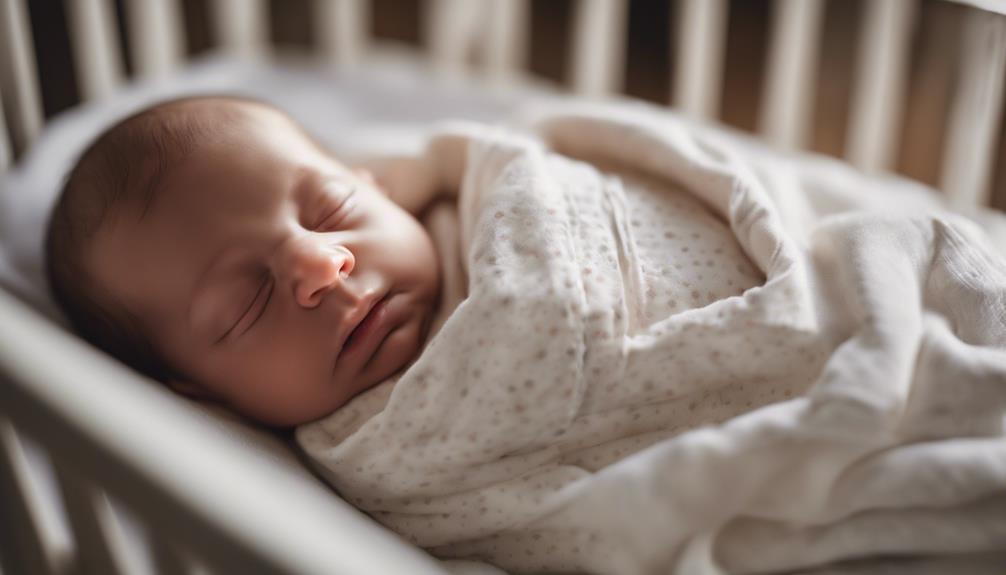
When it comes to newborns, safety guidelines strongly advise against using comforters due to the risk of suffocation. Newborns lack the ability to move objects away from their face, making soft toys like comforters potentially hazardous during sleep. Safe sleep practices recommend a firm, flat surface for babies to rest on, without any loose bedding that could pose a suffocation risk. It's important to prioritize safe sleep over the use of comforters, making sure that the baby's sleep environment is free from potential hazards. While comforters may seem cozy and comforting, the safety of the newborn should always take precedence.
Soft toys, including comforters, aren't considered safe for babies during sleep due to the suffocation risk they pose. Creating a safe sleep environment means avoiding loose bedding like comforters and opting for a minimalist approach to the newborn's sleep space. By following these guidelines, parents can help reduce the risk of accidents and guarantee their baby sleeps soundly and safely.
Optimal Fabric Choices for Newborn Comforters
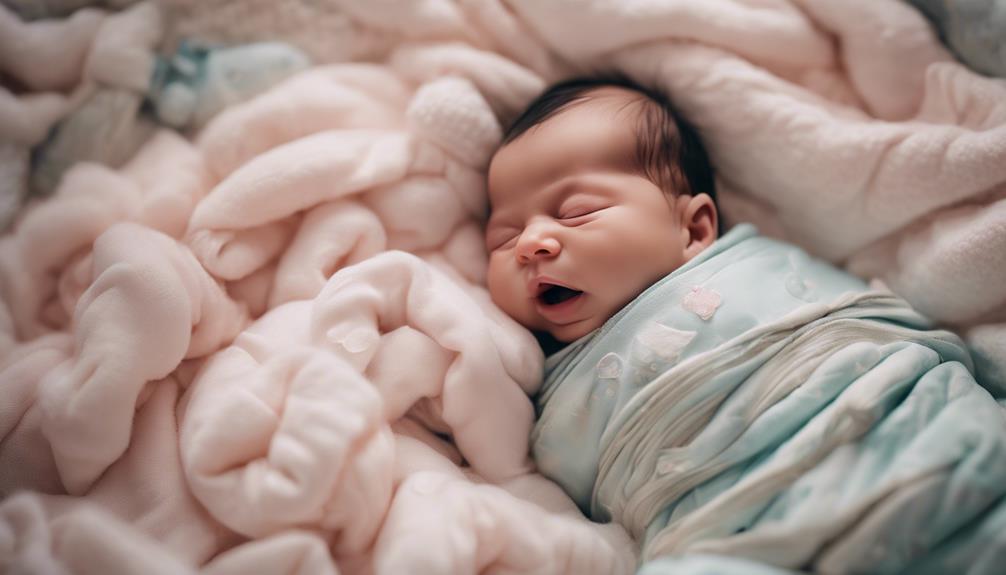
After carefully considering the safety guidelines for newborn comforters, it's vital to think about appropriate fabric choices to guarantee the well-being of the baby.
When choosing a comforter for your little one, prioritize fabrics that are breathable and hypoallergenic like organic cotton. These fabrics can help reduce the risk of allergies and ensure a safe sleeping environment for the baby.
It's important to avoid comforters with embellishments such as buttons or sequins that could pose a choking hazard. Ideal fabric choices for newborn comforters include soft muslin or jersey knit fabric, providing a gentle and cozy feel that's safe for the baby's delicate skin.
Remember to select lightweight comforters that are free of loose threads to prevent any potential suffocation risks. Look for comforters made from OEKO-TEX certified fabrics to make sure they're free from harmful chemicals, further enhancing the safety of your baby's sleeping environment.
Prioritizing safe, soft fabrics for your baby's comforter is crucial for promoting a peaceful and secure sleep experience.
Lightweight Comforters for Newborns
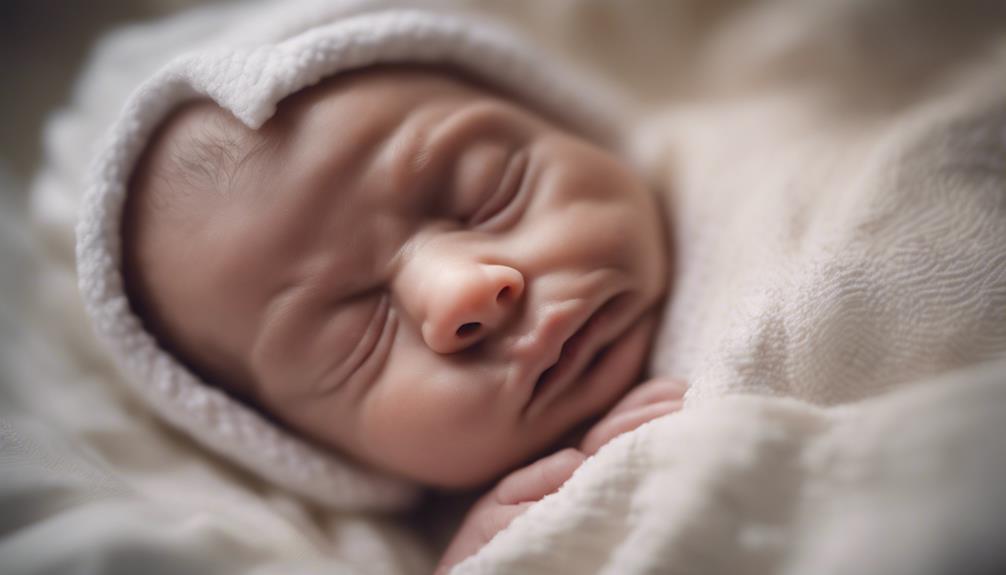
When considering lightweight comforters for newborns, prioritizing their safety is crucial. Look for materials that are breathable and free of small parts or loose threads to prevent choking hazards.
Always choose appropriately sized and lightweight comforters for newborns to minimize the risk of suffocation.
Safety of Newborn Comforters
Lightweight comforters made of breathable fabrics are generally safe for newborns, provided they're free of small parts, ties, or loose threads that could pose a choking hazard. When it comes to ensuring the safety of newborns during sleep, it's essential to choose comforters that are designed with their well-being in mind.
Opt for comforters made of soft, breathable materials like cotton to reduce the risk of suffocation and overheating. Additionally, avoid comforters with non-cotton fabrics or bean fillings that may pose potential hazards. Remember to supervise babies when they're using comforters to prevent any accidents.
While comforters can provide warmth and comfort, it's advisable to wait until babies are a bit older before introducing them to these sleep accessories.
Material Considerations for Newborns
In light of the safety of newborns, it's vital to prioritize the use of lightweight comforters made of breathable, hypoallergenic materials.
When selecting a comforter for your newborn, opt for soft fabrics that are gentle on their delicate skin. Make sure the comforter is securely attached to the baby's sleep environment to prevent any risks of suffocation.
Lightweight comforters can serve as a comforting object for your newborn, promoting a healthy sleep association. Avoid comforters with small parts, ties, or loose threads that could pose a choking hazard.
Always supervise your newborn when using a comforter to ensure safe sleep practices are followed. Prioritizing these material considerations will help create a safe and cozy environment for your little one.
Cleaning Newborn Comforters
To maintain cleanliness and safety for newborns, make sure that their lightweight comforters are machine washable for easy cleaning. When washing these comfort items, opt for a gentle, hypoallergenic detergent to prevent skin irritation on delicate newborn skin.
It's vital to dry the comforters thoroughly to prevent mold or mildew growth, ensuring a safe sleeping environment for your little one. Avoid using fabric softeners or harsh chemicals that could potentially harm your newborn.
Always refer to the manufacturer's guidelines for specific cleaning instructions to maintain the quality and integrity of the comforter. By keeping these cleaning tips in mind, you can guarantee that your newborn's comfort item remains a safe and hygienic object during times of separation anxiety.
Potential Hazards to Avoid With Newborn Comforters

When contemplating newborn comforters, it's important to be aware of potential hazards that should be avoided to safeguard the safety of the infant. Newborns require a safe sleep environment to reduce the risk of Sudden Infant Death Syndrome (SIDS).
Comforters, with their soft bedding, can pose a suffocation hazard and increase the likelihood of SIDS. To help prevent these dangers, it's essential to understand that newborns need to sleep on their back to sleep and in a sleeping bag or other approved sleepwear that guarantees proper ventilation and temperature regulation.
Additionally, comforters with loose parts or attachments can present a choking risk for newborns, as they might accidentally detach and become a hazard during sleep. Following safe sleep guidelines that exclude comforters for newborns is recommended to ensure the infant's well-being and reduce potential risks associated with their use.
Prioritizing the safety of newborns in their sleep environment is paramount, and avoiding comforters is a key step in promoting safe sleep practices.
Benefits of Comforters for Newborn Sleep
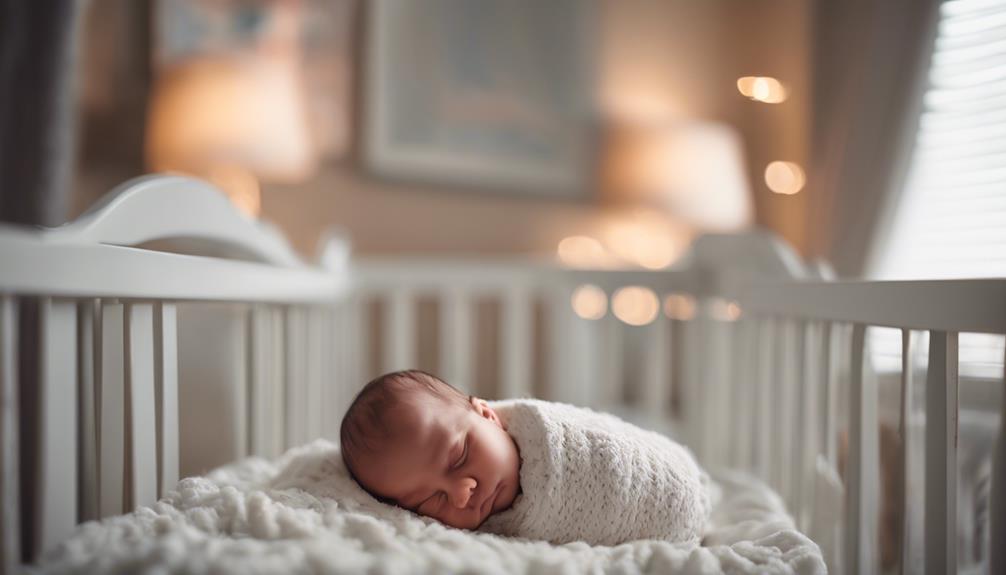
When considering newborn comforters, it's crucial to understand that prioritizing safe sleep practices is paramount for the well-being of infants. While comforters are generally not recommended for newborns due to safety concerns, there are some benefits associated with introducing a comforter around 6 months old when infants are developing skills to help soothe themselves to sleep.
- Comfort and Security: Introducing a comforter can provide a sense of comfort and security for infants as they shift to independent sleep routines around 6 months old.
- Self-Soothing Skills: Comforters can help babies develop self-soothing skills by providing a familiar object to hold onto or cuddle while falling asleep.
- Promotes Better Sleep: Having a comforter in their sleep environment may help some infants relax and settle down more easily, leading to more restful sleep for both the baby and parents.
Recommended Age for Introducing Comforters to Newborns
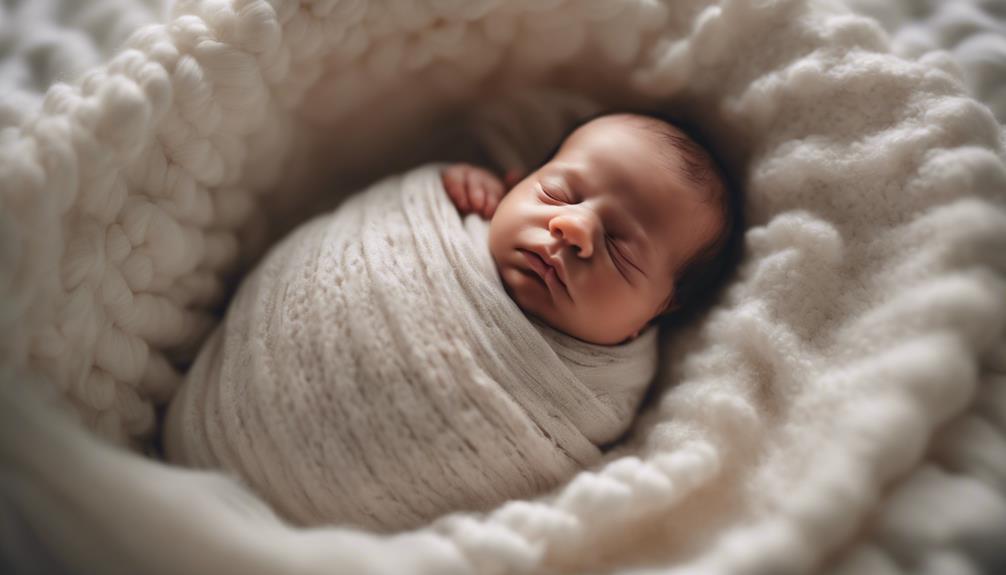
When should you introduce comforters to newborns?
Experts recommend waiting until around 6 months when the risk of SIDS decreases.
Prioritizing a safe sleep environment without comforters is essential to newborns' well-being.
Safe Comforter Usage
Introducing comforters to newborns is generally recommended after they reach at least 6 months of age to prioritize safe sleep practices. While comforters can provide warmth and comfort, safety concerns regarding suffocation risk make it important to delay their introduction.
To guarantee the safest sleep environment for newborns, here are some key points to keep in mind:
- Wait until 6 months: Postpone introducing a comforter until the baby is at least 6 months old to reduce the risk of suffocation.
- Bare sleep environment: Follow the American Academy of Pediatrics guidelines for a safe sleep space, which includes a firm, flat mattress and no loose bedding.
- Monitoring: Always supervise your baby during sleep to make sure the comforter doesn't pose a suffocation hazard.
Benefits for Newborns
Introducing comforters to newborns is typically recommended around the age of 6-12 months to minimize safety concerns and suffocation risks. Newborns have a higher risk of suffocation with loose bedding or soft items in their sleep environment. Safety guidelines advise against placing comforters in a newborn's sleep area to reduce the risk of accidental suffocation.
The recommended age for introducing comforters to newborns aligns with when the risk of SIDS decreases. It's important to prioritize safe sleep practices for newborns, which may involve avoiding the use of comforters until they're older.
Monitoring Newborns With Comforters
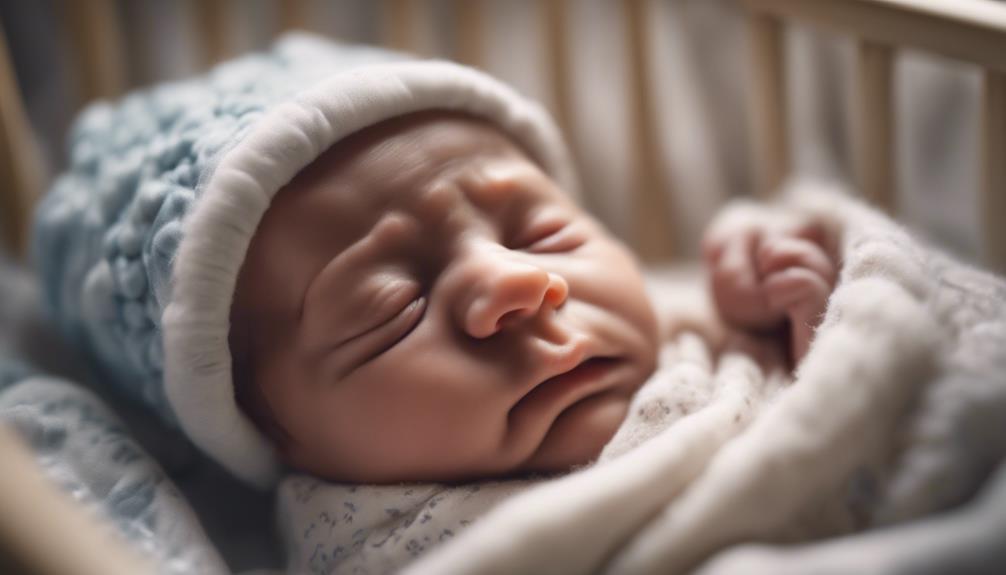
To guarantee the safety of newborns while using comforters, incorporating monitoring devices like sensor mats can offer additional peace of mind. When it comes to babies and children, especially during periods of change like adjusting to new sleep cycles, monitoring their well-being is essential. Here are three ways to effectively monitor newborns with comforters:
- Under-Mattress Monitors: These devices can provide real-time information on your baby's movements and breathing patterns, offering reassurance that they're safe while using a comforter.
- Video Baby Monitors: Opting for a video monitor can allow you to visually check on your baby without disturbing their sleep, ensuring they're comfortable with their comforter.
- Sound Monitors: Listening to your baby's sounds through a monitor can help you stay alert to any potential issues, such as the 'red nose' phenomenon, where a baby's nose appears red due to improper positioning with a comforter.
Ensuring Safe Sleep Environment With Newborn Comforters
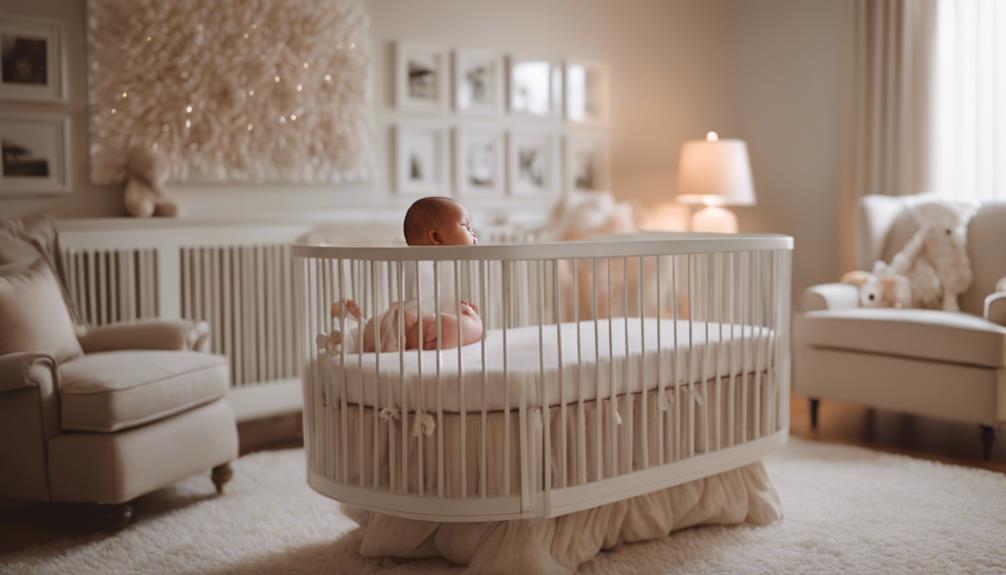
In ensuring a safe sleep environment with newborn comforters, it's important to prioritize the absence of small parts, ties, or ribbons that could pose choking hazards. Newborns are particularly vulnerable to items that could obstruct their airways, so always opt for comforters that are free of any potential choking hazards.
It's essential to choose comforters designed with the safety of newborns in mind, ensuring they provide comfort without compromising on well-being. Some comforters come with attachment hooks to secure them to cot bars, but exercise caution with newborns to prevent any risks of entanglement during sleep. These attachments should be carefully monitored to avoid any potential hazards.
Introducing comforters at bedtime can help newborns associate them with sleep routines, fostering a sense of security. However, parents should be mindful of newborns becoming too attached to comforters, as this attachment might pose safety risks during sleep. Prioritize safety when selecting and using comforters to create a secure and comfortable sleep environment for newborns.
Transitioning From Swaddle to Comforter for Newborns
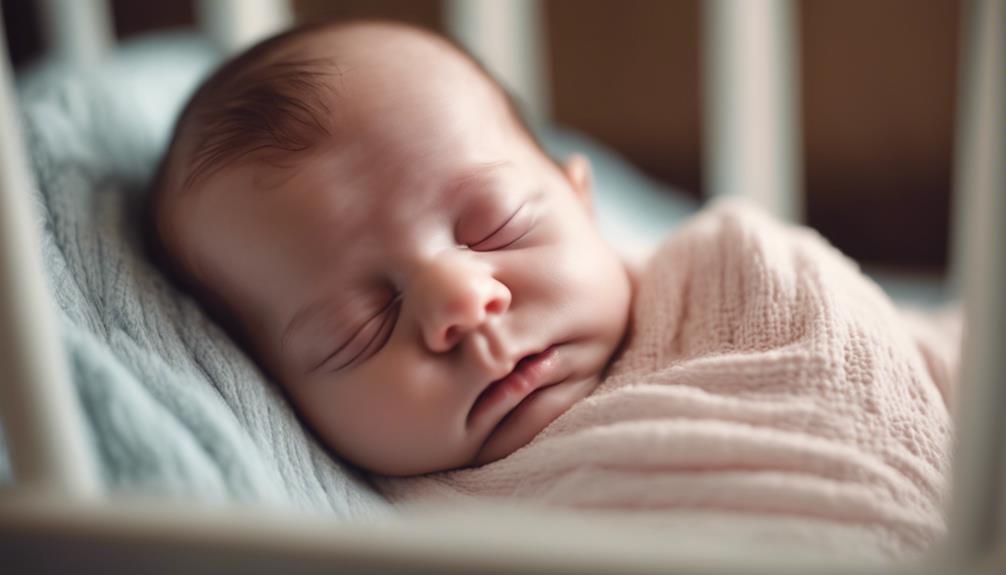
Introducing newborns to comforters instead of swaddling usually starts around 3-4 months of age. Shifting from the secure feeling of being swaddled to the comfort of a soft blanket can be a gradual process.
Here are three essential tips for helping your newborn move from swaddle to comforter:
- Start Slowly: Begin by introducing the comforter during naps or bedtime while still using the swaddle. This allows your baby to become familiar with the new item without feeling overwhelmed.
- Provide Comfort: Comforters can offer a sense of security similar to swaddling. Choose a lightweight and breathable comforter to ensure safety and comfort for your little one.
- Supervise and Monitor: Keep a close eye on your baby when introducing the comforter to prevent any risks of suffocation. Always follow safe sleep guidelines to create a secure sleeping environment for your newborn during this adjustment period.
Final Tips for Using Comforters With Newborns
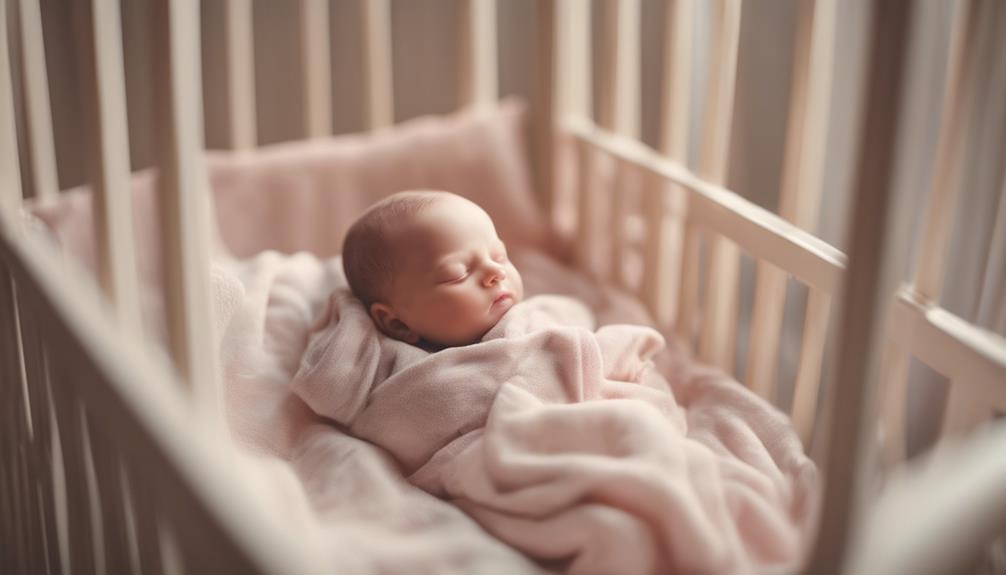
For newborns, prioritizing safety is paramount when considering the use of comforters in their sleep environment. While comforters can provide warmth and comfort, it's important to remember that babies and toddlers have delicate developing skills and may not have the ability to move bedding away from their faces.
If you choose to introduce a comforter to your child's sleep routine, wait until the child is older and can move their head freely to reduce the risk of suffocation. To help them adjust, make sure the comforter is lightweight and breathable to prevent overheating. Additionally, make sure the comforter is securely tucked in around the mattress to prevent it from covering your child's face during sleep.
Always supervise your child when they're using a comforter and follow safe sleep guidelines recommended by pediatric experts to reduce the risk of Sudden Infant Death Syndrome (SIDS). Your child's safety is the top priority when it comes to introducing comforters into their sleep environment.
Frequently Asked Questions
Can I Give My Newborn a Comforter?
Yes, giving your newborn a comforter isn't recommended for safety reasons. Newborns can't easily move away from objects that may cause suffocation.
To guarantee safe sleep, follow guidelines from the American Academy of Pediatrics and use a firm, flat sleep surface without soft bedding like comforters.
Wait until your baby is older and has better head control before introducing a comforter.
Prioritizing safe sleep practices is essential for newborns.
Are Baby Comforters SIDS Safe?
Studies show that pacifier use can reduce SIDS risk in newborns. Dentist-approved pacifiers can prevent dental problems. Regularly check pacifiers for wear to guarantee safety.
Avoid non-cotton fabrics for comforters to lower SIDS risks. Keep comforters small and light to prevent suffocation. Always prioritize safety when choosing items for newborns to promote a healthy environment.
When to Introduce a Comforter to a Baby?
When to introduce a comforter to a baby depends on their age. For newborns, it's best to wait until they're at least 6 months old. Babies under 6 months have a higher risk of suffocation with soft bedding items like comforters.
To prioritize safe sleep practices, the American Academy of Pediatrics advises against placing any soft objects in a baby's sleep environment. Remember, safety comes first when it comes to introducing comforters to newborns.
What Bedding Should a Newborn Have?
When considering bedding for a newborn, it's crucial to prioritize safety. Our little ones should sleep on a firm, flat mattress with just a fitted sheet to reduce the risk of suffocation and SIDS.
Avoid using comforters, blankets, or pillows in the crib. Instead, opt for swaddling with a breathable blanket or using sleep sacks to keep them cozy without any hazards.
Following safe sleep guidelines like the ABCs (Alone, on their Back, in a Crib) is key for a secure sleeping environment.
Can I Introduce a Comforter to My Newborn?
It is generally recommended to wait until the age for comforter suitability before introducing a comforter to a newborn. This is typically around 6 to 12 months old. At this stage, a comforter can provide a sense of security and comfort for the baby, but always ensure it is safe and age-appropriate.
Conclusion
To sum up, comforters can be safe for newborns when used appropriately. Just like a gentle lullaby soothes a restless baby, a soft comforter can provide warmth and security for peaceful sleep.
By following safety guidelines, choosing the right fabric, and monitoring your newborn, you can create a cozy sleep environment that promotes restful nights.
Remember, a well-loved comforter can be a comforting companion for your little one, ensuring sweet dreams and a sense of comfort.
Comforter
Why Do Babies Need a Comforter
Only with a comforter can babies find the essential emotional soothing and security they need for development – discover why in this insightful article.
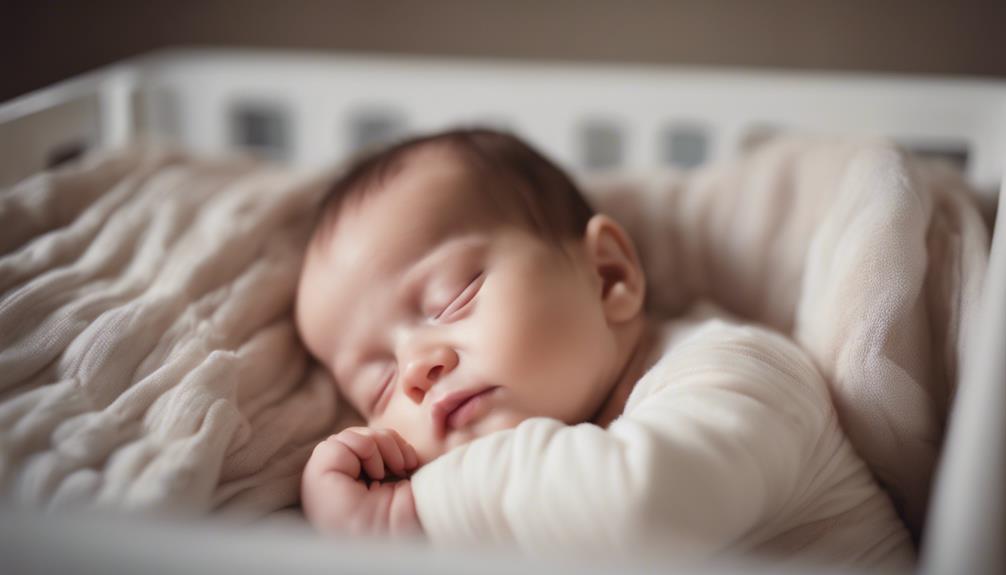
Babies require a comfort object for crucial emotional comfort and security. This item plays a key role in helping them feel safe, secure, and assists in self-soothing techniques. Comfort objects serve as familiar items that provide security during stressful situations, promoting comfort and reassurance while helping to manage emotions. They are essential for important developmental stages, nurturing attachment and a secure bond. Additionally, comfort objects support self-regulation skills, emotional stability, and overall well-being. Furthermore, they promote a sense of calmness during playtime and bedtime, establishing positive sleep patterns and helping babies deal with separations and changes. Explore the importance of comfort objects for babies.
Key Takeaways
- Comforters provide emotional soothing and security for babies.
- They aid in self-soothing and emotion management.
- Comforters offer familiarity and support in stressful situations.
- They promote emotional security and stability.
- Comforters help babies feel calm, settled, and secure.
Emotional Soothing and Security
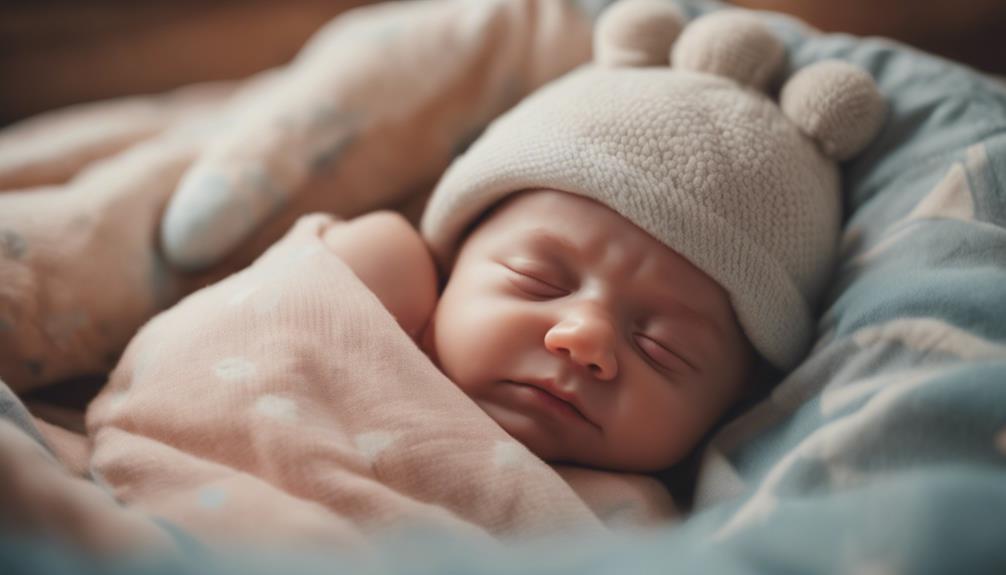
Comforters play an essential role in providing babies with emotional soothing and security through familiar and comforting objects. When a baby forms an attachment to a comforter, it doesn't signify insecurity but rather a vital way to feel safe and secure. The presence of a comforter aids in self-soothing and helps babies manage their emotions, offering a sense of comfort and reassurance. Introducing a comforter around 7-9 months aligns with an important developmental stage where babies seek reassurance and comfort during sleep and wake times.
The emotional benefits of comforters are profound, as they serve as a source of comfort, security, and familiarity for babies, especially during moments of stress or fatigue. By providing a tangible source of comfort, comforters become a reliable companion for babies, offering them a sense of security and emotional support throughout their early years. This attachment to a comforter can significantly contribute to a baby's overall well-being and emotional development.
Sense of Familiarity and Support
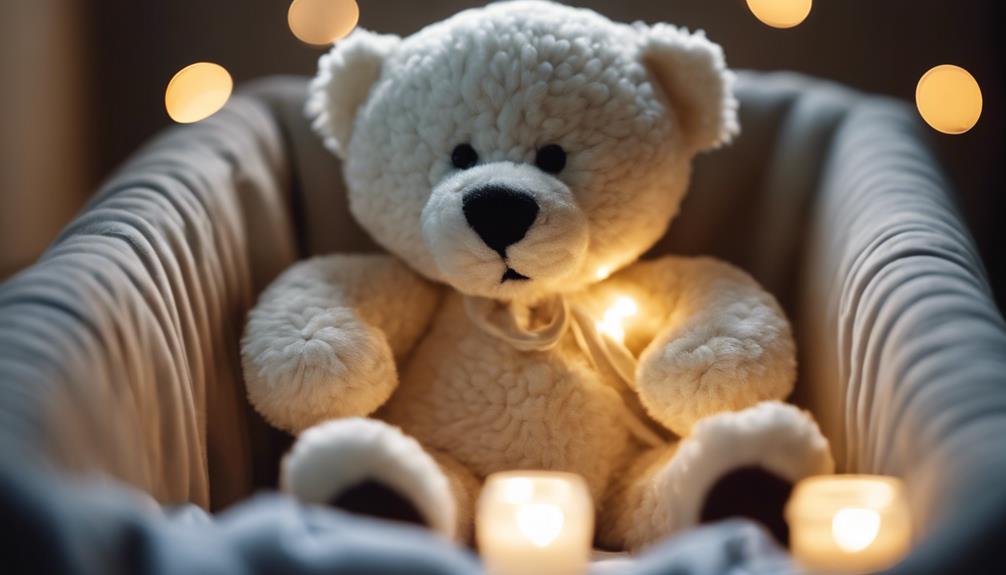
During times of stress or change, babies benefit from the sense of familiarity and support provided by their comforters. Comforters play an important role in helping babies feel safe and secure, promoting a sense of comfort and reassurance.
Here are three ways in which comforters contribute to babies' well-being:
- Familiarity: Comforters act as familiar objects that babies can rely on, especially during unfamiliar or unsettling situations. This familiarity helps babies feel more at ease and secure, providing a sense of continuity and stability in their environment.
- Security: The presence of a comforter offers babies a sense of security, which is essential for their emotional development. Feeling secure allows babies to explore their surroundings with confidence and develop a sense of independence over time.
- Emotional Support: Comforters serve as a source of emotional support, enabling babies to self-soothe and manage their emotions effectively. This emotional regulation is beneficial for babies' overall well-being and helps them navigate different emotional states with more ease.
Aid in Self-Soothing
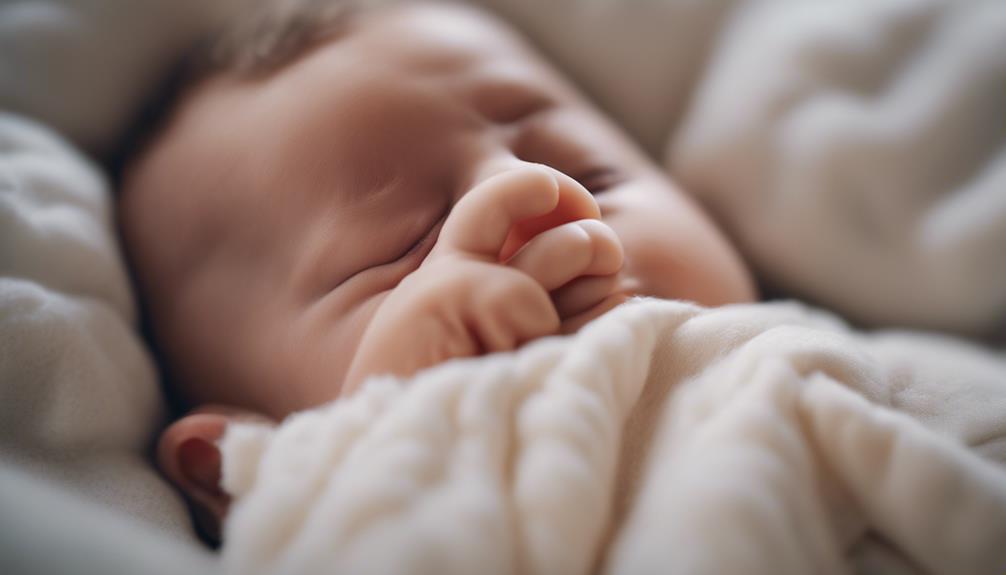
An essential aspect of supporting babies' emotional development is helping them learn to self-soothe independently. Comforters play a vital role in aiding babies in self-soothing by providing a familiar and comforting object that they can rely on.
When faced with situations like separation or change, having a comforter can assist babies in managing their emotions and reducing stress. The presence of a comforter offers a sense of security and reassurance to babies, contributing to their emotional stability.
Babies often form a strong attachment to their comforter, which helps them feel safe and comforted in various circumstances. This attachment not only promotes emotional security but also supports the development of self-regulation skills and coping mechanisms for handling emotional distress.
Promotion of Emotional Security

Moving on from aiding in self-soothing, we now explore how comforters promote emotional security in babies.
Comforters play an essential role in promoting emotional security for babies through various means:
- Attachment: Babies develop a strong attachment to their comforters, forming a secure bond that provides them with a sense of safety and comfort.
- Consistency and Familiarity: Comforters offer a consistent source of familiarity, which can be comforting for babies, especially during times of stress or change.
- Emotional Regulation: Comforters aid in self-soothing and emotional regulation, helping babies manage their emotions more effectively.
By providing a source of comfort and stability, comforters contribute to the overall well-being and security of the baby.
The presence of a beloved comforter can help babies feel settled, calm, and secure in various situations, enhancing their emotional stability and promoting a sense of well-being.
Calmness During Playtime and Bedtime
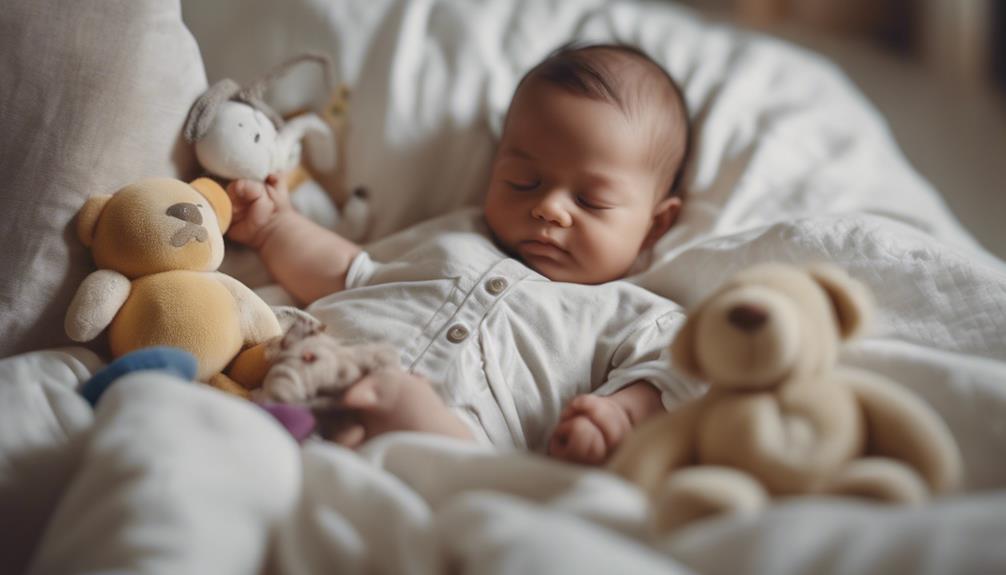
We find that comforters play a significant role in fostering a sense of calmness for babies during both playtime and bedtime routines. Babies rely on their comforters as a source of security and comfort, turning to these soothing objects to help them relax and feel at ease in various environments. This sense of comfort provided by the comforter can aid in establishing a positive shift association, contributing to better sleep patterns for babies.
Using a comforter as a intermediary object can assist babies in coping with separations and changes during playtime and bedtime. The emotional support and stability offered by the presence of a comforter can help babies navigate both playful and restful times with a sense of relaxation and reassurance.
| Keyword | Description |
|---|---|
| Security | Provides a sense of safety and protection for babies |
| Comfort | Offers a feeling of ease and contentment |
| Soothing Object | Helps babies relax and feel calm |
Frequently Asked Questions
What Is the Purpose of a Comforter for a Baby?
Comforters play a vital role in helping babies manage their emotions and provide a sense of love and comfort in times of need.
Introducing a comforter around 7-9 months aids in promoting self-soothing behaviors and helps babies seek reassurance.
Attachment to a comforter doesn't imply insecurity; rather, it supports emotional security through predictable responses from caregivers.
What Age Should a Baby Comforter Be?
When to introduce a baby comforter varies, but around 7-9 months is typical. This age is when babies start seeking emotional soothing and security. By introducing a comforter at this stage, we help them develop a sense of reassurance during stressful times.
Between 6-12 months, babies may form a strong attachment to their comforter, aiding in self-soothing and emotional regulation. It's an important period for building a healthy emotional foundation.
Why Is Bedding Important for Babies?
Bedding is crucial for babies as it offers a sense of security and comfort, aiding in their emotional development. It helps babies self-soothe, manage emotions, and promotes better sleep. Establishing a positive sleep association with bedding makes bedtime routines easier and pleasant.
During changes like weaning or daycare, bedding provides familiarity and comfort. Introducing bedding around 7 months can foster a healthy attachment and coping mechanism for various situations.
How Can a Comforter Help Babies to Settle?
Comforters can create a sense of security for babies, aiding in emotional soothing and self-regulation. Introducing a comforter around 7-9 months can help establish positive sleep associations. Babies may form attachments to comforters, providing comfort during changes and sleep.
Using a comforter can support calmness and better sleep patterns. This small object plays a significant role in a baby's emotional well-being and sleep habits.
Conclusion
In summary, babies need a comforter for emotional soothing, security, and self-soothing. It provides a sense of familiarity and support, promoting emotional security and calmness during playtime and bedtime.
So, next time your little one reaches for their comforter, remember it's not just an ordinary object – it's an essential tool for their well-being and development.
Embrace the comforter, embrace the calmness.
Comforter
Can I Vacuum My Comforter
Tackle the question of whether you can vacuum your comforter and discover the best practices for keeping it fresh and fluffy.
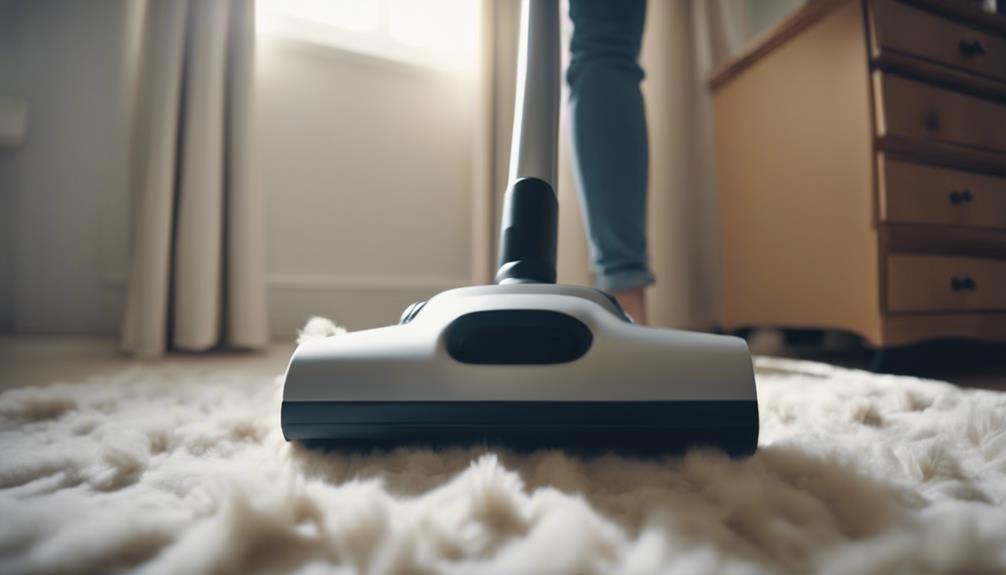
When vacuuming your comforter, be sure it is clean and dry. Avoid vacuuming down or feather-filled comforters. Once you vacuum pack it, allow the comforter to air out and fluff it up. Allowing it to air out removes trapped air and helps keep it fresh. Remember to vigorously shake the comforter after washing and use tennis balls in the dryer for added fluffiness. Opt for a breathable storage bag and regularly air out your comforter to ensure longevity. Vacuum frequently with an upholstery attachment and avoid using high suction settings. Take care to maintain the hygiene and loftiness of your comforter. For more detailed instructions on the best way to care for your comforter, continue reading.
Key Takeaways
- Vacuum synthetic-filled comforters for space efficiency.
- Avoid vacuuming down or feather-filled comforters.
- Ensure comforter is clean and dry before vacuuming.
- Vacuuming helps remove allergens and dirt for cleanliness.
- Use proper vacuuming technique to maintain comforter quality.
Benefits of Vacuum Packing Comforters
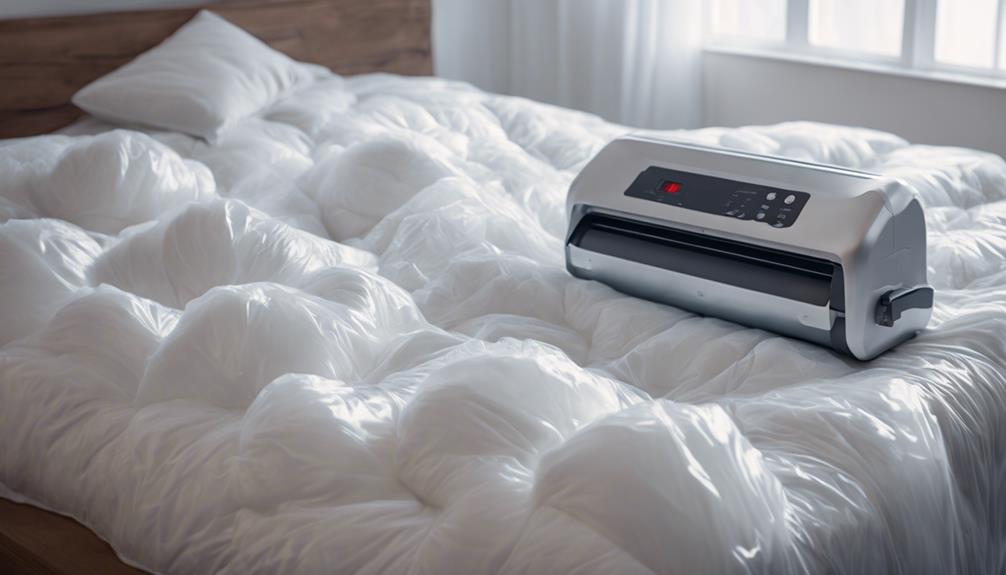
Vacuum packing comforters maximizes storage space while safeguarding them from dampness and odors, making it an efficient solution for compact living spaces. When vacuum packing comforters, the process removes excess air from the storage bag, allowing the comforter to compress into a smaller size. This method not only saves space but also provides protection against moisture and unwanted smells that can affect the comforter's freshness.
Suitable Comforter Types for Vacuum Packing
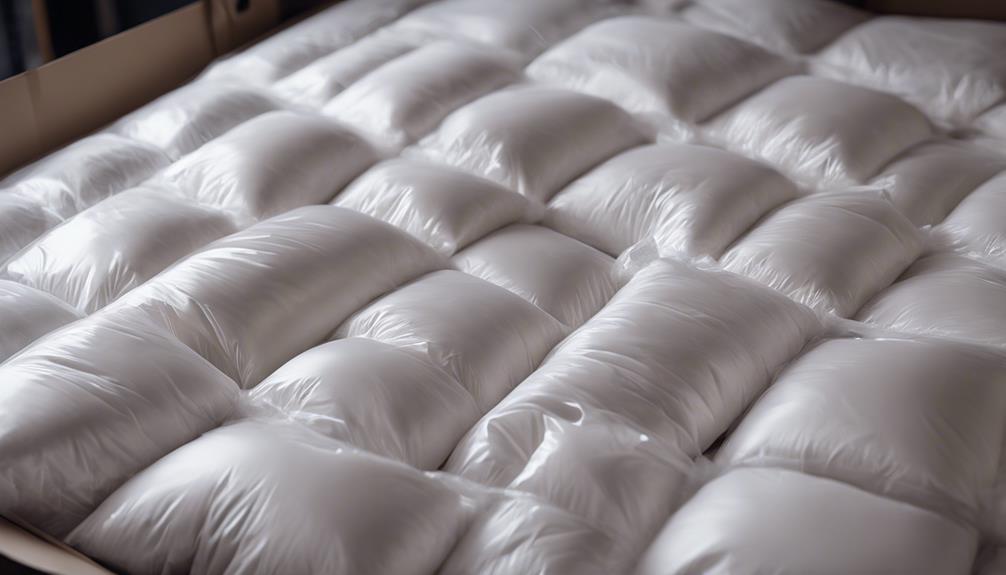
Synthetic-filled comforters are ideal candidates for vacuum packing to maximize storage efficiency and save space. Their construction allows them to compress easily, reducing bulkiness when stored.
Comforters filled with synthetic materials can be tightly packed using a vacuum seal bag, making them perfect for those looking to save space in their closets or storage areas.
On the other hand, down and feather-filled comforters aren't as suitable for vacuum packing. The compression from vacuum sealing can cause these types of comforters to lose their loft and insulation over time, impacting their overall quality and warmth.
It's important to take into account the filling material of your comforter before opting for vacuum packing to guarantee the longevity and effectiveness of the bedding. By choosing the right type of comforter for vacuum packing, you can efficiently utilize storage space while keeping your bedding in top condition.
Preparing Your Comforter for Vacuum Packing
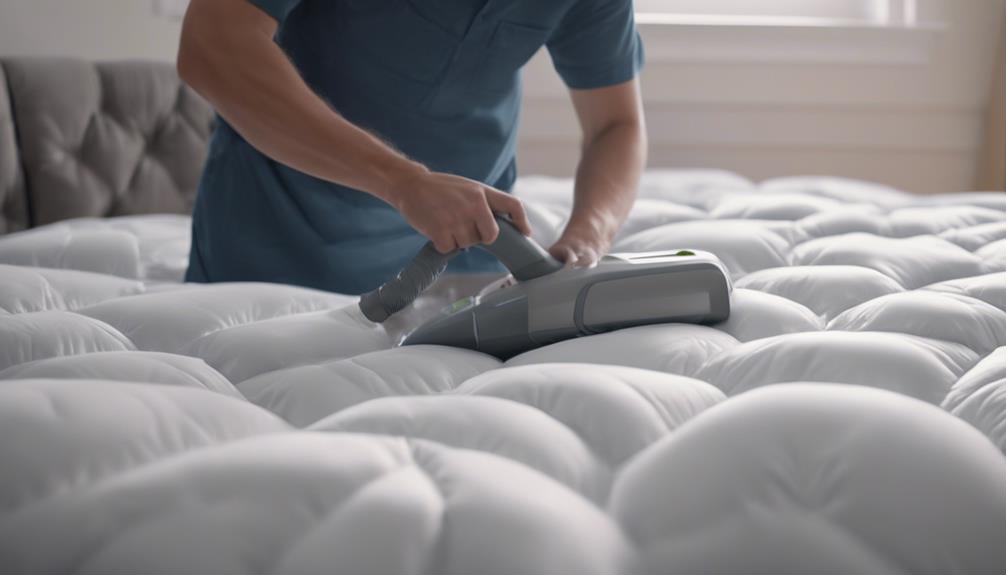
When contemplating preparing your comforter for vacuum packing, it's crucial to make sure it is clean and dry to prevent mold or mildew growth. Before vacuum packing your comforter, spot clean any stains for a thorough cleaning process. Vacuum packing not only saves space but also protects the comforter from dampness and odors during storage. However, avoid vacuum packing down or feather comforters as it may damage the filling and affect their fluffiness. After vacuum packing, make sure to air out the comforter before use and fluff it up to restore its original shape and comfort.
| Cleaning Tips for Comforter Vacuum Packing |
|---|
| Step 1: Check for stains on the comforter and spot clean them. |
| Step 2: Ensure the comforter is completely dry before vacuum packing. |
| Step 3: Use a gentle detergent for any necessary washing before packing. |
| Step 4: Allow the comforter to air out after vacuum packing for a fresh feel. |
| Step 5: Gently fluff the comforter to restore its softness and shape. |
Vacuum Packing Process for Comforters
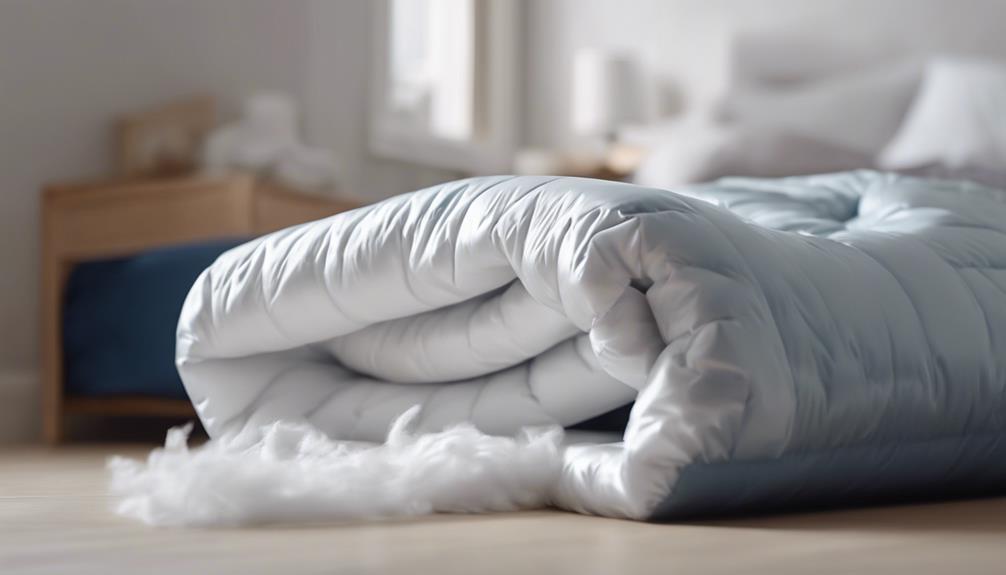
When vacuum packing comforters, it's crucial to contemplate the advantages of this process, the correct vacuuming technique, and the frequency needed for top-notch maintenance.
By vacuuming our comforters, we can effectively eradicate dust mites, allergens, and dirt, promoting a cleaner and healthier sleeping environment.
Understanding the proper vacuuming method and how frequently to perform this task can contribute to extending the lifespan of our comforters and ensuring their continued fluffiness and insulation properties.
Vacuuming Comforter Benefits
By vacuuming your comforter regularly, you can effectively remove dust, dirt, and allergens that accumulate over time, promoting cleanliness and prolonging its lifespan. Here are some benefits of vacuuming your comforter:
- Clean and Fresh: Regular vacuuming helps keep your comforter clean and fresh.
- Prevents Growth of Unwanted Organisms: It can prevent the growth of mold, mildew, and dust mites in your comforter.
- Prolongs Lifespan: By removing dust and dirt, vacuuming can help extend the lifespan of your comforter.
Vacuuming your comforter not only maintains its cleanliness but also guarantees you have a cozy and healthy sleeping environment.
Proper Vacuum Technique
To properly vacuum pack your comforter, make sure you use a vacuum cleaner with a brush attachment to gently remove dust, dirt, and allergens from the fabric surface. When vacuuming your comforter, it's crucial to avoid applying excessive pressure to prevent any damage to the comforter's filling or fabric. By using the brush attachment, you can effectively clean the comforter without causing harm.
Regular vacuuming of your comforter not only helps in maintaining its cleanliness but also extends its lifespan by keeping it fresh and free from allergens. Periodically vacuuming your comforter is a simple yet effective way to guarantee a hygienic sleeping environment and preserve the quality of your bedding. Remember, gentle vacuuming with the right attachment is key to keeping your comforter clean and cozy.
Frequency of Vacuuming
Regularly vacuuming your comforter is essential for maintaining cleanliness and freshness, ensuring a hygienic sleeping environment, and extending the lifespan of your bedding. When it comes to vacuuming your comforter, it's recommended to do so monthly. Here are some reasons why this frequency is important:
- Removal of Dust and Allergens: Monthly vacuuming helps remove accumulated dust, allergens, and debris that can affect air quality.
- Prevention of Deep Settling Dirt: By vacuuming your comforter monthly, you can prevent dirt and dust from settling deeply into the fabric, helping to preserve its quality.
- Healthier Sleeping Environment: Regular vacuuming contributes to a healthier sleeping environment by reducing potential allergens that may impact your sleep quality.
Airing Out Vacuum-Packed Comforters
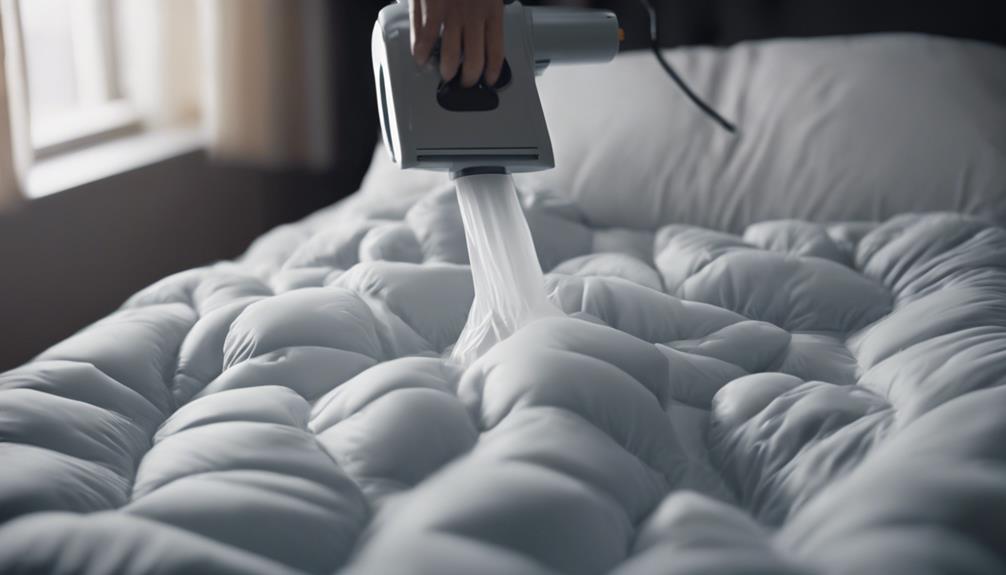
When airing out vacuum-packed comforters, it's essential to allow them to fully expand and breathe before vacuuming for best fluffiness. This process helps remove any trapped air and guarantees a thorough cleaning of the comforter.
Airing out and vacuuming your comforter regularly can maintain its freshness and extend its lifespan.
Vacuuming Process for Comforters
Vacuuming our comforters with a brush attachment helps effectively remove dust, dirt, and allergens, maintaining their freshness and extending their lifespan.
When vacuuming your comforter, remember to:
- Use gentle pressure to avoid damaging the fabric.
- Make sure the vacuum cleaner has a brush attachment for a thorough clean.
- Regularly vacuum to keep your comforter fresh and clean.
Benefits of Airing Out
Airing out vacuum-packed comforters is an essential step in maintaining their freshness and ensuring maximum comfort. When we air out our comforters, we help redistribute the filling evenly, which can freshen the bedding and prevent clumping. Direct sunlight exposure during airing can also be beneficial, as it can help eliminate bacteria and viruses present in the comforter. However, it's important to avoid leaving the bedding on the line overnight to prevent moisture retention. In case outdoor space is limited, using a tumble dryer on a low setting can aid in airing out the comforter effectively. Remember to regularly shake the bedding during airing to maintain its fluffiness and promote proper air circulation.
| Benefit of Airing Out | Description |
|---|---|
| Redistribute filling | Evenly distributes filling to prevent clumping |
| Eliminate bacteria and viruses | Direct sunlight exposure can help eliminate germs |
| Prevent moisture retention | Avoid leaving bedding on the line overnight |
| Use of tumble dryer | Helpful when outdoor space is limited |
| Maintain fluffiness | Regularly shake the bedding for proper fluffiness |
Maintenance Tips for Comforters
Maintaining the freshness and comfort of vacuum-packed comforters involves essential steps, such as airing them out properly to redistribute the filling evenly and prevent clumping. When it comes to comforter maintenance, here are some key tips for airing out your bedding effectively:
- Hang It Outdoors: Hanging duvets outside or near an open window allows sunlight to eliminate bacteria and viruses.
- Use a Tumble Dryer: If outdoor space is limited, using a tumble dryer on a low setting can help air out comforters effectively.
- Avoid Overnight Dampness: It's recommended to avoid leaving bedding on the line overnight to prevent dampness. Regularly shaking and airing out duvets is vital for maintaining their quality and cleanliness.
Fluffing and Redistributing Comforter Filling
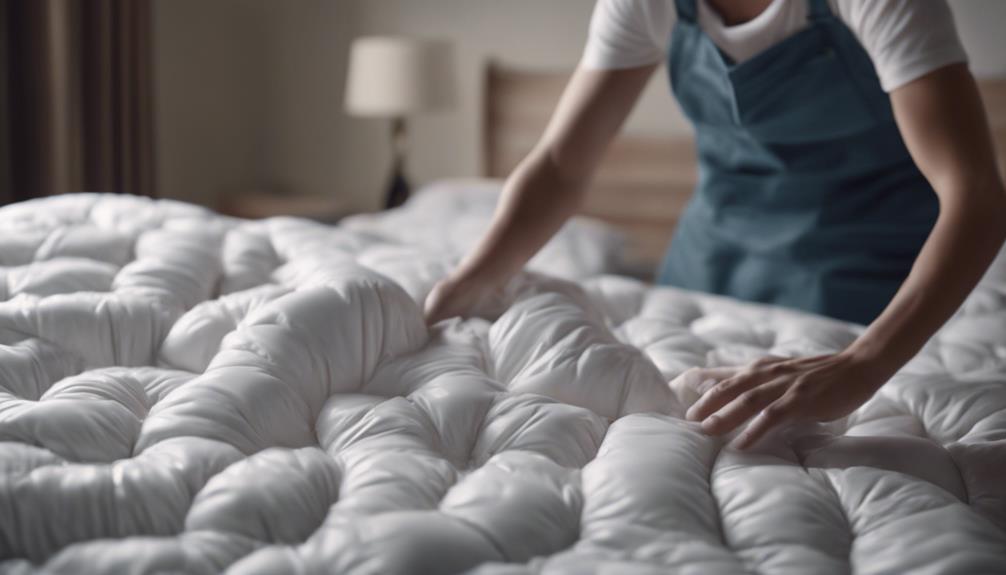
To guarantee maximum warmth and comfort from your comforter, fluffing and redistributing the filling regularly is essential. After washing your comforter, it's important to shake it vigorously to help redistribute the filling evenly.
You can also use a lint roller to remove any excess lint that may have accumulated on the comforter. For a more thorough fluffing, consider adding a few tennis balls into the dryer when drying your comforter; the balls will help to agitate the filling and prevent it from clumping together.
By incorporating these simple techniques into your regular comforter care routine, you can make sure that the filling stays evenly distributed, preventing any uncomfortable lumps or shifts. This not only maintains the comforter's original loftiness but also extends its lifespan and preserves its insulation properties.
Tips for Optimal Comforter Storage
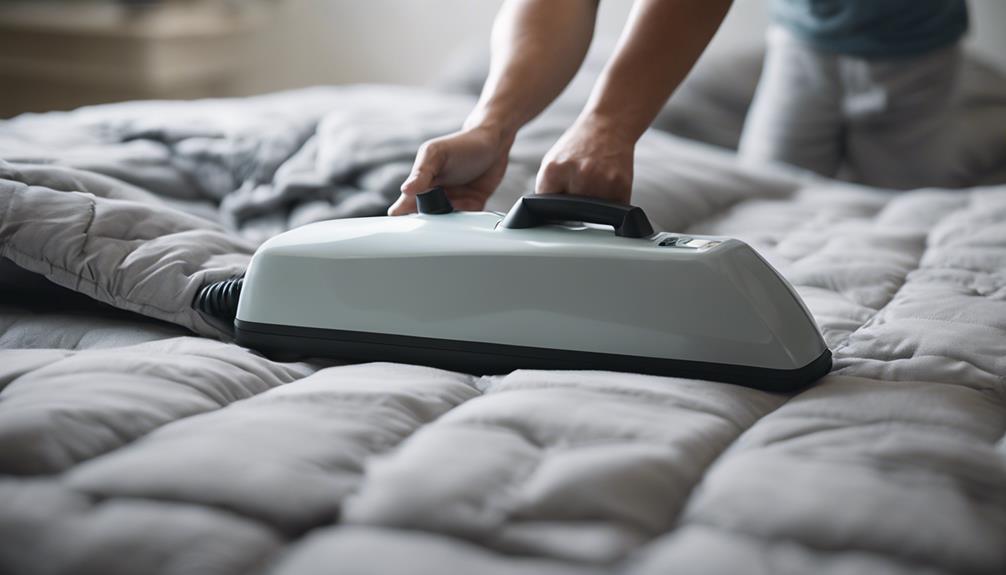
When it comes to ideal comforter storage, choosing the right storage bag is key. Make sure to select a breathable bag that allows air circulation to prevent musty odors.
Additionally, remember to air out your comforter periodically to keep it fresh and fluffy for ultimate comfort.
Storage Bag Options
Exploring various storage bag options enhances the efficiency of storing comforters compactly. When it comes to storing comforters, utilizing vacuum sealing bags can be a game-changer. These bags not only reduce the volume of comforters by up to 80%, saving valuable storage space, but also help protect comforters from dust, moisture, and odors during storage.
To make the most of vacuum sealing, make sure the comforter is clean and completely dry before sealing. Additionally, vacuum sealing bags can offer a cost-effective and efficient solution for storing bedding items like comforters.
Consider these options to keep your comforters in top condition and maximize your storage space:
- Vacuum sealing bags reduce volume by up to 80%
- Protect comforters from dust, moisture, and odors
- Make sure comforter is clean and dry before sealing
Air Out Periodically
Periodically airing out your comforter helps maintain its freshness and eliminates trapped odors. To freshen up your comforter, consider hanging it outside or near an open window to allow for natural ventilation. This process can effectively eliminate bacteria and viruses, keeping your comforter clean and fresh.
If outdoor space is limited, using a tumble dryer on a low setting can achieve a similar effect. Additionally, direct sunlight exposure can help sanitize your comforter and maintain its freshness. Remember to shake your comforter regularly to redistribute the filling and guarantee proper aeration for best storage.
Risks of Vacuum Packing Down Comforters
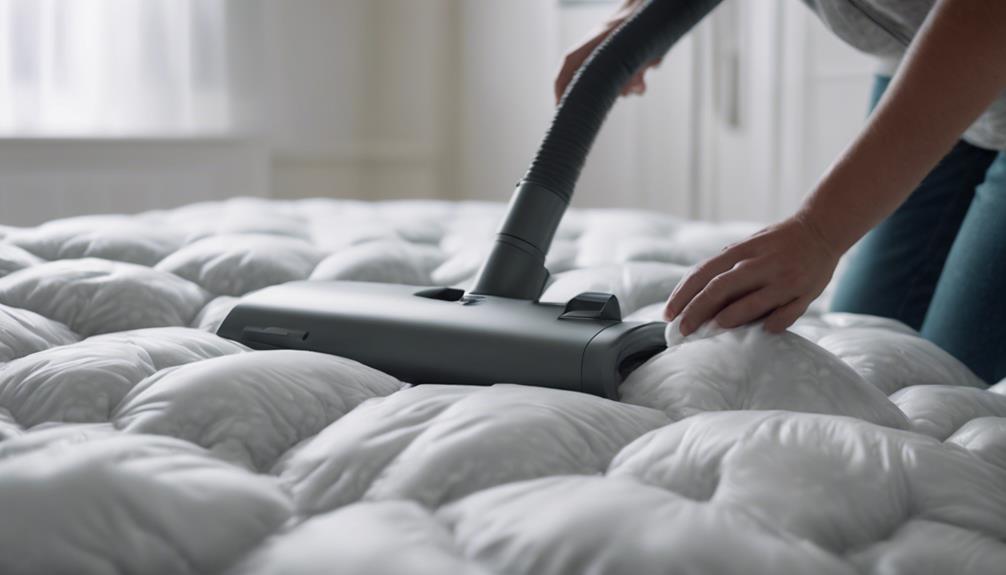
Vacuum packing down comforters poses risks that can compromise their loft, warmth, and overall quality. When considering vacuum packing your down comforter, it's essential to understand the potential drawbacks:
- Loss of Fluffiness: The compression caused by vacuum packing can lead to down clusters sticking together, resulting in a less fluffy and less warm comforter.
- Moisture and Mildew: Down comforters need to breathe to maintain their quality. Vacuum packing restricts airflow, creating a potential environment for moisture buildup and mildew growth.
- Warranty Concerns: Vacuum packing may void the warranty of your down comforter. Altering the structure of the filling through compression can impact the integrity of the comforter and its warranty coverage.
To preserve the loft, warmth, and longevity of your down comforter, it's advisable to avoid vacuum packing and instead opt for proper storage methods.
Cleaning and Maintaining Vacuum-Packed Comforters
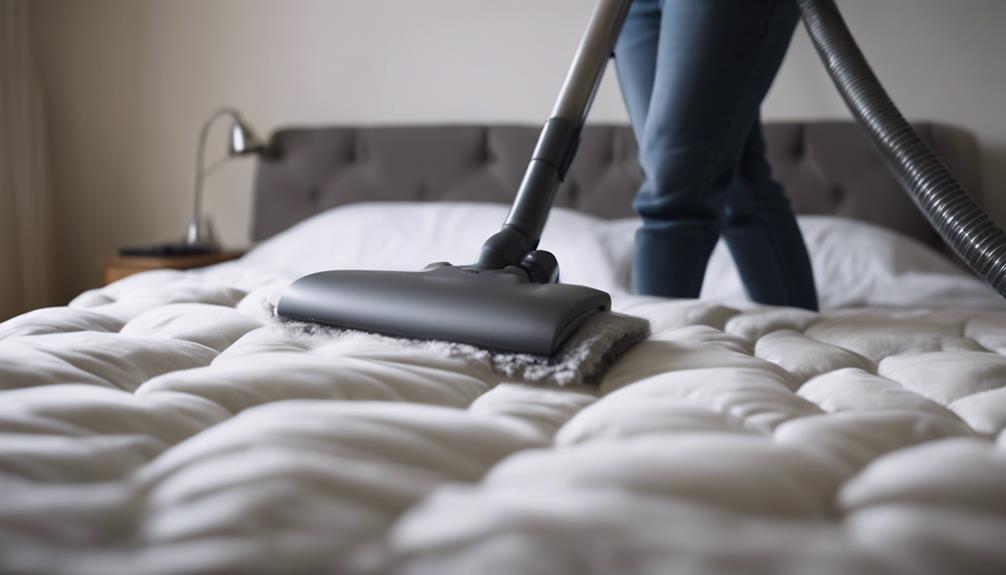
Regularly cleaning and maintaining vacuum-packed comforters is essential for ensuring their longevity and cleanliness. Vacuuming your comforter helps to remove dust, dirt, and allergens that can accumulate in the fibers over time.
To effectively clean your comforter, use a vacuum cleaner with an upholstery attachment. Be sure to avoid using a high suction setting to prevent any damage to the fabric. Additionally, using a lint roller can help remove any hair or lint that may be stuck to the comforter.
Dust mites are a common issue with bedding, so regular vacuuming can help eliminate these microscopic pests and keep your comforter fresh between washings. By incorporating these cleaning techniques into your routine, you can maintain the quality and hygiene of your vacuum-packed comforter for years to come.
Alternative Storage Methods for Comforters
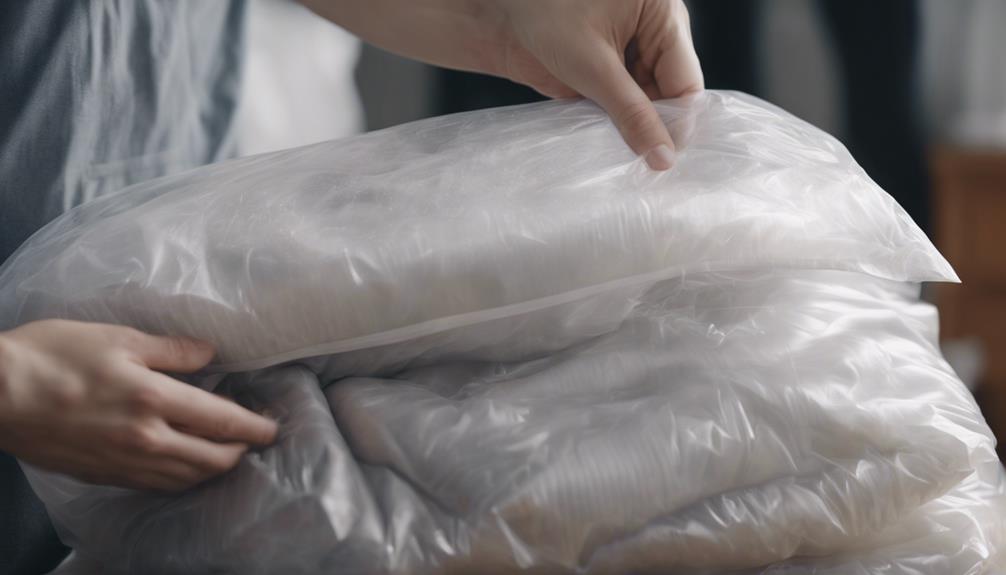
Exploring diverse storage options enhances the longevity and freshness of comforters beyond vacuum packing. When looking for alternative methods to store your comforter, consider the following options:
- Duvet Covers: Investing in duvet covers can provide an extra layer of protection for your comforter while also adding a decorative touch to your bedding. Duvet covers are easy to remove and wash, making it convenient to keep your comforter clean and fresh.
- Fabric Softener: Adding a touch of fabric softener to your laundry routine can help keep your comforter soft and smelling pleasant. Be sure to follow the care instructions on your comforter to determine if fabric softener is suitable for the fabric.
- Delicate Cycle: When washing your comforter, opt for the delicate cycle on your washing machine to ensure gentle cleaning. This setting is ideal for maintaining the quality of your comforter while effectively removing dirt and odors.
Frequently Asked Questions
How to Vacuum Your Bedding?
When vacuuming your bedding, start by using a vacuum cleaner with a brush attachment. Begin at the top and work your way down, ensuring you cover the entire surface. Pay special attention to seams, edges, and any decorative elements to effectively remove debris.
Regular vacuuming helps maintain cleanliness and prolongs the life of your bedding. Vacuuming your bedding can remove dust, dirt, and allergens trapped in the fabric, promoting a healthier sleep environment.
Can I Vacuum a Blanket?
Yes, vacuuming a blanket is a great way to remove dust, dirt, and allergens, helping to keep it clean and fresh.
Using a vacuum cleaner with appropriate attachments is essential to prevent any damage to the fabric.
Regular vacuuming can also prolong the lifespan of the blanket and make sure it stays free of pet hair.
Can I Clean a Blanket With Vacuum Cleaner?
Yes, cleaning a blanket with a vacuum cleaner is an ideal way to remove dirt, dust, and allergens. Using a vacuum with a brush attachment on a low setting helps prevent damage. Regular vacuuming can extend the blanket's lifespan and keep it fresh.
Remember to spot clean stains before vacuuming for best results. Vacuuming is a simple and efficient method to maintain the cleanliness of your blanket.
How Do You Get Dust Out of a Comforter?
To get dust out of a comforter, gently vacuum it with a brush attachment. This helps remove trapped debris, maintaining freshness and cleanliness. Avoid high suction settings to prevent fabric damage.
Regular vacuuming reduces allergens, creating a healthier sleep environment. Remember, a clean comforter promotes better sleep and overall well-being.
Vacuum periodically for best results and enjoy a cozy, dust-free bed.
Conclusion
To sum up, vacuum packing your comforter can be a convenient and space-saving storage solution.
By following the proper steps and precautions, you can safely vacuum pack your comforter to keep it fresh and protected.
Remember to choose the right type of comforter for vacuum packing, prepare it properly, and store it in a cool, dry place.
With these tips in mind, you can guarantee your comforter stays in great condition for future use.
Comforter
Comforter When to Use
Journey into the world of introducing a comforter to your baby, starting around 7-9 months for enhanced sleep and comfort—discover more benefits ahead!
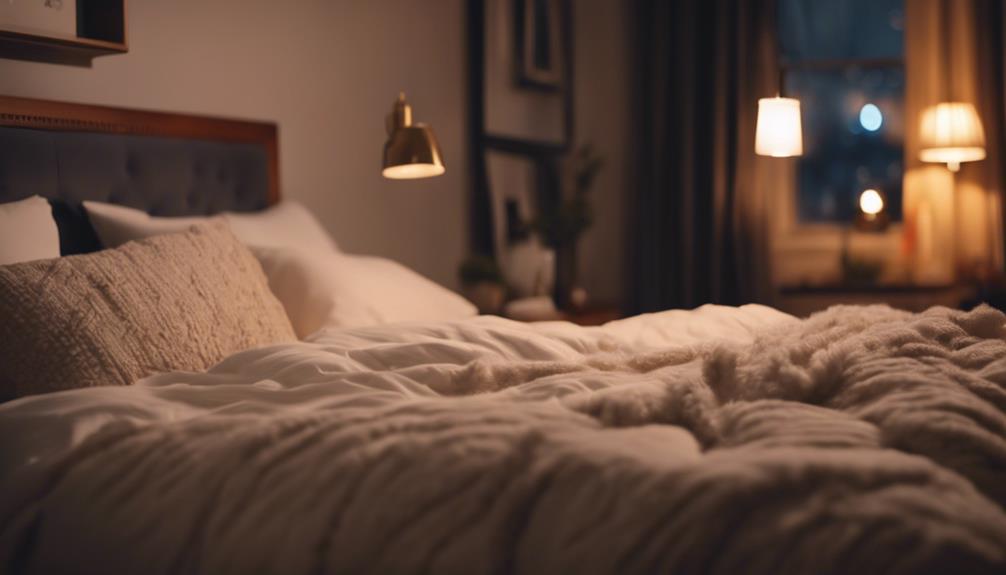
When is the right time to give your baby a comforter? It’s recommended to introduce it around 7-9 months. At this age, babies begin seeking reassurance and comfort, which helps build positive sleep habits. It’s best to avoid introducing a comforter before 7 months due to safety concerns such as suffocation and choking risks. Benefits of introducing a comforter include providing warmth, security, and promoting better sleep quality. Select materials like cotton for breathability or silk for a more luxurious feel. Prioritize safety by choosing options that are free of choking hazards and always supervise your baby’s use of the comforter. When introducing the comforter, make it a regular, safe, and consistent part of your baby’s sleep routine. Comforters can help with self-soothing, support sleep training, and foster strong attachments. For safe and soothing sleep, choose a comforter wisely and start around 7 months – it’s crucial for your baby’s well-being.
Key Takeaways
- Introduce comforters around 7-9 months for security and positive sleep associations.
- Comforters offer warmth, comfort, and emotional soothing for babies.
- Establish stronger attachments with comforters at this age.
- Avoid risks by waiting until 7 months to introduce comforters.
- Use age-appropriate, safe, and breathable comforters for optimal sleep support.
Safe Age to Introduce Comforter
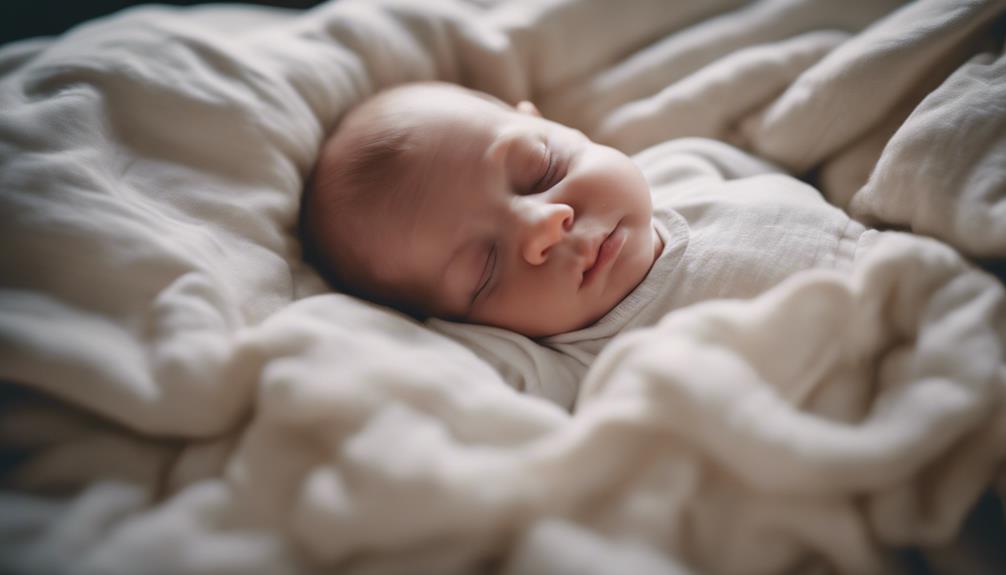
Around 7-9 months is considered the vital age to introduce a comforter to babies as they begin seeking reassurance and comfort during this developmental stage. Waiting until this age allows babies to establish a positive sleep association with the comforter. Babies are more likely to engage with and benefit from a comforter around this time.
Introducing a comforter too early may not be as effective in promoting self-soothing and security. It's essential to choose a safe and breathable comforter when introducing it to babies around 7 months. By waiting until this stage, parents can observe their baby's readiness for a comforter and make sure it becomes a helpful tool in promoting comfort and security during sleep.
This age range aligns with the developmental milestones where babies start forming stronger attachments to objects for comfort, making it an ideal time to introduce a comforter into their sleep routine.
Risks of Early Comforter Use

Using a comforter before the age of 7 months can pose serious risks to a baby's safety during sleep. Infants at this age lack the ability to move bedding away from their faces, increasing the potential for suffocation.
It's important to wait until after 7 months to introduce a comforter to reduce the risk of choking hazards and promote healthy self-soothing skills.
Potential Choking Hazard
Introducing a comforter to infants too early notably raises the risk of choking hazards due to their limited ability to remove objects from their mouths. Babies under 7 months are at a higher risk of choking on small comforter parts. To reduce the likelihood of choking incidents, safety guidelines recommend introducing comforters around 7-9 months when babies have developed better motor skills and coordination. Waiting until the baby is older can greatly decrease the chances of choking incidents related to comforter use. Below is a table illustrating the potential choking hazards associated with early comforter use:
| Age of Infant | Risk of Choking Hazard |
|---|---|
| Under 7 months | High |
| 7-9 months | Reduced |
| Over 9 months | Low |
Delayed Self-Soothing Skills
We must carefully consider the potential risks associated with introducing a comforter to babies too early, especially regarding the delay of their natural self-soothing skills. When babies rely heavily on a comforter for soothing, they may not learn essential self-soothing techniques.
Overuse of the comforter can hinder a baby's ability to calm themselves independently. This delay in self-soothing skills can lead to sleep disruptions when the comforter isn't available.
To promote healthy self-soothing development in babies, it's essential to strike a balance in comforter use. Encouraging babies to learn how to soothe themselves without external aids is beneficial for their overall well-being and independence.
Benefits of Comforter for Babies
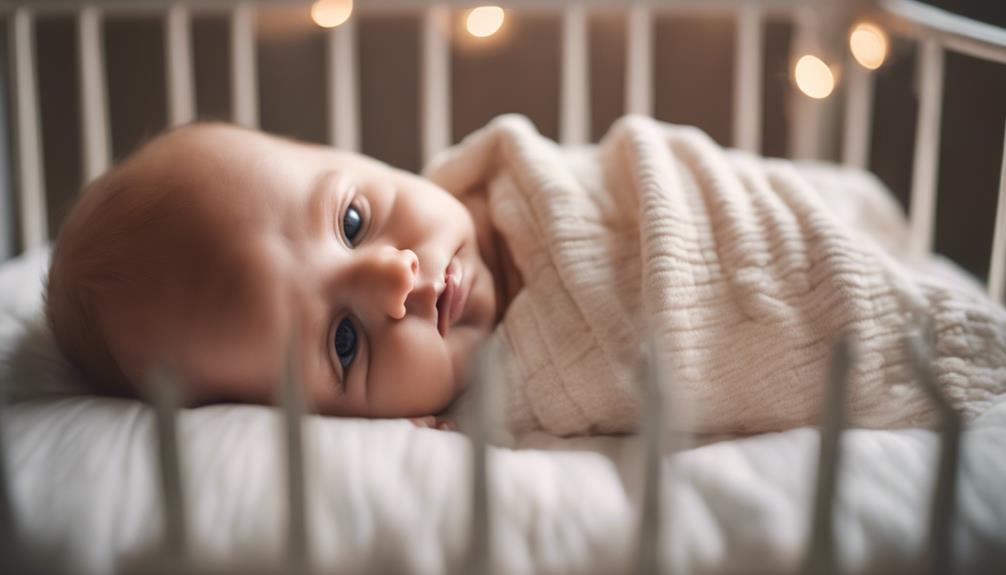
Comforters offer babies warmth, security, and comfort as they navigate their sleep routines. These soft blankets can provide a soothing touch, helping infants feel safe and content during bedtime.
Additionally, comforters can act as a sleep aid, assisting babies in settling down and enjoying a restful night's sleep.
Warmth for Baby
Providing essential warmth and insulation, a comforter offers babies a cozy and regulated sleeping environment, guaranteeing ideal body temperature maintenance during rest. Babies benefit greatly from the added layer of warmth provided by a comforter, especially on colder nights or in rooms with drafts. This helps prevent overheating or chilling, creating a comfortable and snug sleeping space for your little one. By using a comforter, you are promoting a peaceful and restful sleep routine, supporting healthy sleep patterns and development. To make sure it's safe for babies, always choose a lightweight and breathable comforter suitable for their age. Below is a table summarizing key points about using a comforter for your baby:
| Benefits of a Comforter for Babies |
|---|
| Regulates body temperature |
| Prevents overheating or chilling |
| Enhances sleep quality |
Security and Comfort
Moving from ensuring warmth for your baby, let's now explore how comforters contribute to their sense of security and comfort. Comforters play an essential role in providing emotional soothing, security, and comfort to babies, helping them feel safe in new situations.
Contrary to what some may think, a baby's attachment to a comforter doesn't suggest insecurity; instead, it fosters emotional security through the love and predictability in parents' responses. By using comforters, babies learn to self-soothe, manage their emotions, and develop healthy attachments that aid in maneuvering changes smoothly.
Introducing comforters safely involves familiarizing babies with the item during playtime and bedtime routines, ensuring it's safe and washable, and allowing supervised use before 7-12 months to promote healthy sleep habits.
Sleep Aid for Infants
Embracing a sense of security and comfort, infants benefit greatly from the soothing presence of a familiar comfort item during sleep. Introducing a comforter when a baby starts to show signs of attachment, typically around 7-9 months, can assist in promoting self-soothing behaviors and a sense of safety.
Babies can form healthy attachments to their comforter, aiding in bedtime routines and changes. The comforter can also help manage emotions and provide comfort during episodes of separation anxiety. Using a safe and appropriate comfort item is essential to promote a sense of security and aid in soothing babies to sleep.
It's important to choose a comforter that's suitable for the baby's age and developmental stage, ensuring a safe and comforting sleep environment.
Comforter Vs. Blanket for Sleep

Comparing comforters to blankets for sleep reveals distinct benefits in promoting self-soothing and positive sleep associations for babies. When deciding between the two, here are some key points to take into account:
- Emotional Soothing: Comforters, unlike blankets, are specifically designed to provide emotional comfort and security during sleep.
- Bedtime Routine: Comforters can become part of a bedtime routine, helping babies associate them with sleep and relaxation.
- Safety: Comforters are safer alternatives to blankets in cribs, reducing the risk of suffocation or overheating.
- Self-Soothing: Introducing a comforter around 7 months can aid in adjustments and help babies learn to self-soothe during the night.
Choosing the Right Comforter Material
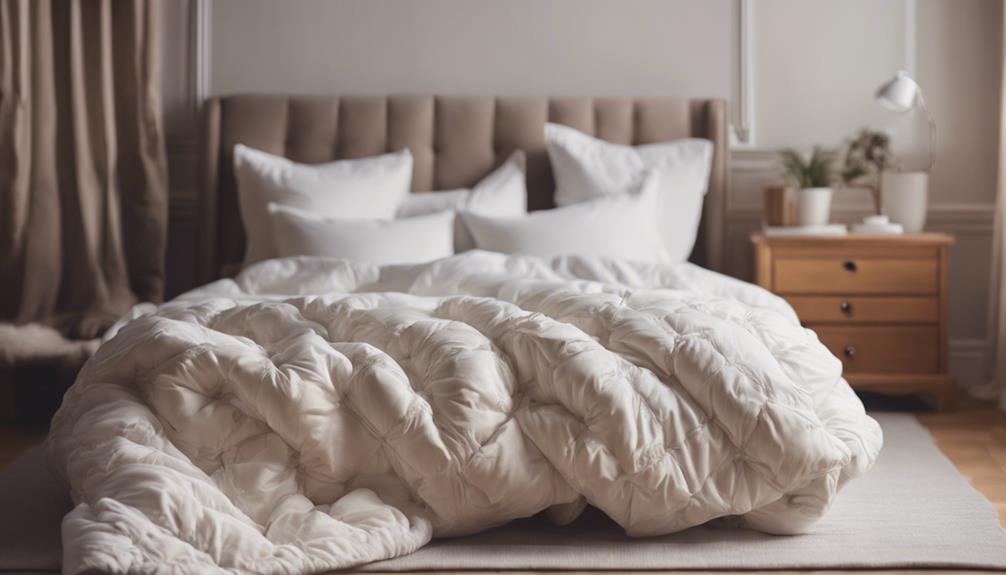
When selecting the right comforter material, it's important to explore different types of materials for comparison. Factors like warmth versus weight and allergy-friendly options play a significant role in determining the best comforter material for your needs.
Material Types Comparison
We often consider the material types when choosing the right comforter for our needs. Here are some comparisons to help you make an informed decision:
- Cotton: Breathable and easy to care for, ideal for those with allergies or sensitive skin.
- Wool: Excellent for temperature regulation, naturally moisture-wicking and insulating.
- Down: Lightweight yet provides excellent warmth, perfect for cold winter nights.
- Silk: Luxurious and hypoallergenic, offering a smooth and soft feel for a comfortable night's sleep.
Each material has its unique benefits, so consider your preferences and needs, whether it's for yourself, a baby to sleep safely, or for anyone seeking a good night's rest.
Warmth Vs. Weight
Finding the perfect balance between warmth and weight is essential when selecting the ideal comforter material for a comfortable night's sleep. To help you make an informed decision, we've prepared a comparison table below:
| Comforter Material | Warmth Level | Weight |
|---|---|---|
| Down Fill | High | Medium |
| Synthetic Fill | Moderate to High | Light |
| Cotton | Moderate | Light |
Considering the connection between sleep quality and comfort, it's vital to choose a comforter that provides adequate warmth without feeling too heavy. This balance is especially important for child health, as children's sleep can be influenced by the right bedding materials. By carefully evaluating warmth versus weight, you can ensure a restful night's sleep for yourself and your loved ones.
Allergy-Friendly Options
For individuals with allergies, selecting hypoallergenic materials such as cotton, bamboo, or silk is crucial when choosing an allergy-friendly comforter. When considering allergy-friendly options for your comforter, keep the following in mind:
- Avoid down-filled comforters: Down can trigger allergic reactions in some individuals.
- Look for certifications: Opt for comforters that are Oeko-Tex or GOTS certified to guarantee they're free from harmful chemicals.
- Regular washing: Wash your bedding, including the comforter, regularly in hot water to remove dust mites and allergens.
- Use a duvet cover: Choose a duvet cover that's easy to remove and wash frequently to maintain cleanliness and reduce allergens.
Comforter Safety Guidelines

Guarantee the comfort item chosen for your baby is free of potential choking hazards to secure their safety during sleep. When considering comforter safety guidelines, it's important to prioritize safe sleep practices. Select a comforter that's age-appropriate and doesn't have small parts that could detach and pose a choking risk. Always follow safe sleep recommendations when introducing a comforter to your baby's sleep routine to reduce the risk of accidents or suffocation. It's essential to supervise the use of comforters during sleep to monitor your baby's safety and well-being closely.
Stay informed about safe sleep practices in your region to create a secure sleep environment for your baby. By being proactive and knowledgeable about potential risks and safety guidelines, you can ensure that your baby's sleep space is free of hazards. Prioritizing comforter safety guidelines and safe sleep practices will help provide a safe and comfortable sleeping environment for your little one.
Transitioning to a Comforter

After guaranteeing the safety of the comforter for your baby, it's beneficial to gradually introduce it around 7 months to promote independent self-soothing. Shifting to a comforter can be a smooth process with the right approach. Here are some steps to contemplate:
- Incorporate the Comforter into Feeding and Wind-Down Routines: Utilize the comforter during feeding times or as part of a calming wind-down routine before naps or bedtime. This helps the baby associate the comforter with positive experiences.
- Choose a Safe and Breathable Comforter: Opt for a comforter made from breathable materials to ensure comfort and safety for your baby. Avoid comforters with small parts that could be a choking hazard.
- Sleep with the Comforter to Transfer Your Scent: Sleeping with the comforter for a few nights can transfer your scent onto it, helping your baby feel more secure and comforted when using it.
- Be Consistent and Patient: Consistency is key when shifting to a comforter. It may take time for your baby to form a strong association with the comforter, so be patient and persistent in your efforts.
Comforter for Sleep Training

Introducing a comforter around 7 months can greatly aid in the sleep training process by assisting babies in self-soothing independently. During sleep training, a comforter serves as a reassuring object that helps babies feel secure and calm in their cribs. Here is a table outlining the benefits of using a comforter for sleep training:
| Comforter for Sleep Training | Benefits |
|---|---|
| Assists in self-soothing | Enables babies to comfort themselves |
| Establishes positive association | Creates a link between comforter and sleep |
| Promotes consistency | Helps in establishing a routine |
| Supports patience | Encourages gradual progress in sleep habits |
| Enhances security | Becomes a source of comfort during changes |
Comforter for Self-Soothing

When incorporating a comforter for self-soothing, babies learn to rely on a source of comfort and security to promote independent sleep habits. Here are some key points to keep in mind when using a comforter for self-soothing:
- Promoting Self-Soothing: Comforters help babies develop self-soothing skills by providing a sense of security and familiarity, which can assist in calming them during sleep times.
- Reducing Reliance on Parental Intervention: By introducing a comforter, babies may learn to soothe themselves without constant parental involvement, fostering a sense of independence.
- Establishing Positive Sleep Associations: Introducing a comforter around 7 months can help create positive sleep connections for babies, aiding in their bedtime routines and changes.
- Forming Healthy Attachments: Consistently introducing the comforter with patience can help babies form healthy bonds to it, which can serve as a reliable source of comfort for self-soothing purposes.
Comforter Usage Tips
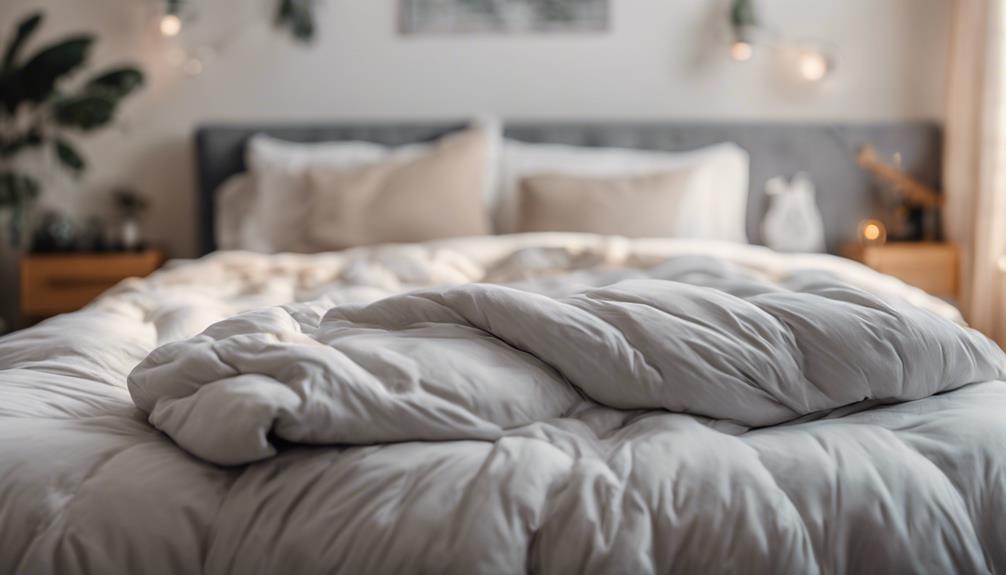
For the best comforter usage, make sure to choose a breathable and safe option for your baby's sleep environment. Introducing a comforter around 7 months can assist your baby in self-soothing independently, helping them establish positive sleep associations.
Consistency is key – use the comforter during feeds and wind-downs to create a routine that signals bedtime. Opt for a comforter that's gentle on your baby's delicate skin and allows for proper airflow to prevent overheating.
To enhance the comforter's effectiveness, consider sleeping with it for a night or two to transfer your scent, providing added security for your baby.
Frequently Asked Questions
What Is the Purpose of a Comforter?
The purpose of a comforter is to provide babies with a sense of security and aid in self-soothing during sleep. It establishes positive sleep associations and helps in bedtime routines, fostering independence and emotional comfort.
Using a comforter consistently can help babies form healthy attachments and manage emotions effectively. Introducing a comforter around 7 months can promote independence and provide familiarity during changes, offering comfort in various situations.
Are Comforters for Summer or Winter?
For summer or winter use, comforters serve varied purposes. In summer, opt for lightweight options with breathable fabrics to prevent overheating. These keep you cool while providing comfort.
Conversely, winter comforters offer warmth with heavier fills and insulating materials. Select based on the season's temperature and your personal comfort preferences. Both types cater to different needs for a cozy night's sleep, ensuring you rest comfortably year-round.
Are You Supposed to Use a Comforter as a Blanket?
Yes, you can use a comforter as a blanket, but it's important to take safety guidelines into account.
For babies, it's best to avoid using a comforter due to suffocation and overheating risks. Instead, opt for a thin blanket or sleep sack after 18 months.
Soft bedding should be avoided to prevent suffocation hazards. Waiting until at least 18 months to use a blanket can help guarantee a safer sleep environment.
When Can You Introduce a Comforter at Night?
We can introduce a comforter at night around 7 months of age to help babies self-soothe and establish positive sleep associations.
Consistency and patience in using a comforter can aid in developing a comforting sleep routine.
Ensuring the comforter is safe and breathable is vital for the baby's emotional comfort and security.
Conclusion
To sum up, introducing a comforter to your baby at the right age can provide benefits like self-soothing and comfort during sleep.
Remember to choose a safe material and gradually shift to avoid any risks. Using a comforter can aid in sleep training and promote independent sleep habits.
So, when in doubt, remember that a comforter can be a cozy companion for your little one, like a warm hug on a chilly night.
-
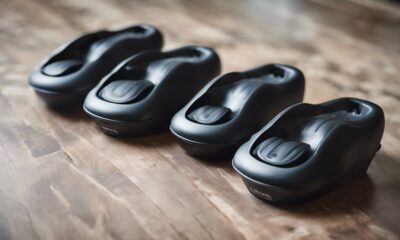
 Vetted8 months ago
Vetted8 months ago15 Best EMS Foot Massagers for Neuropathy to Soothe Your Feet
-

 Vetted7 months ago
Vetted7 months ago14 Best Personalized Father's Day Gifts for Your Husband – Show Him You Care
-

 Alfresco7 months ago
Alfresco7 months agoAlfresco Stacker Doors: Seamless Indoor-Outdoor Living!
-

 Tableware and Dining Accessories3 weeks ago
Tableware and Dining Accessories3 weeks agoWhat Is the Meaning of the Word Tableware
-

 Vetted5 days ago
Vetted5 days ago15 Best Detergents for Wool: Keep Your Woolens Looking Fresh and Fabulous
-

 Tableware and Dining Accessories3 weeks ago
Tableware and Dining Accessories3 weeks agoWhen Is Tableware on Sale at Hobby Lobby
-

 Tableware and Dining Accessories3 weeks ago
Tableware and Dining Accessories3 weeks agoWhich of the Following Is Not Classified as Tableware
-

 Vetted2 months ago
Vetted2 months ago15 Best Home Water Filtration Systems of 2025: A Comprehensive Comparison Guide





















